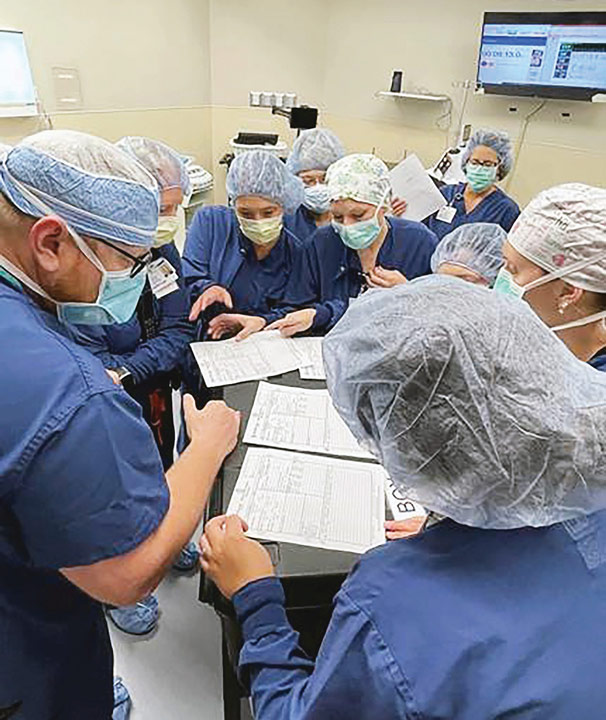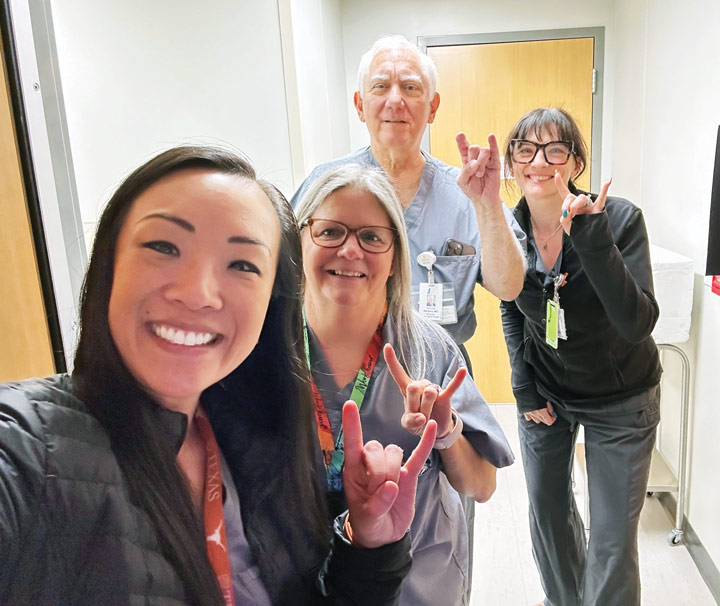- Home
- The Magazine
- Article
You’ve Got This
By: Maria Marabito | OSM Contributor
Published: 4/1/2025
Here’s help avoiding the most common accreditation deficiencies.
Ambulatory surgery centers face intense scrutiny each year as they endure rigorous inspections to ensure they are providing top-tier patient care and safety. Despite best efforts, however, deficiencies continue to appear on survey reports. From lapses in infection control to wonky governance issues, these issues can lead to citations, fines and even threats to your facility’s accreditation.
By understanding the most common survey deficiencies and implementing proactive solutions to address them, ASCs can enhance compliance, improve patient outcomes and avoid costly penalties.
Four areas of focus
Outpatient Surgery Magazine spoke with several experts in the field about this topic. Here’s a look at what they say are the most frequently cited deficiencies — and how to most effectively rectify them.
1 Safety drills. Mock drills of external and internal emergency and disaster preparedness plans are integral to survey readiness. However, some facilities take the easy route with such drills, which can impact not only their ability to pass surveys but, even more importantly, their response to such events if they actually occur. The issue here is that these drills should be based on realistic scenarios.
“Many times, the drills will be documented as completed, but there is no scenario given for the drill,” notes Kathy W. Beydler, MBA, RN, CNOR, CASC, managing partner at Strategic Surgical Solutions in Nashville, Tenn.
It’s not surprising that surveyors drill down on this issue, as proper emergency preparedness goes beyond checking off boxes on a list. There are industry standards surrounding these drills for a reason. Scenario-based drills better ensure that staff know what to do in a real-life situation, such as when a patient cannot move independently during an emergency.
Underestimating the importance of drilling for emergency scenarios is a critical mistake, according to Jessica Hovland, DNP, RN, CPAN, NE-BC, PGMT-BC, senior director at UT Health Austin Ambulatory Surgery Center, who knows from personal experience.
“In the last few years, we’ve had tornado threats, several ice storms — one time the neighboring hospital used our facility as beds for clinicians who couldn’t make it home because the ice was so bad,” she says. “Patient safety means being prepared, so look at the egress routes, make sure there are tactile exit signs and confirm that the emergency generator will kick on when it’s needed.” Surveyors agree.
2 Governance and documentation. Governance and documentation play a vital role in maintaining accreditation and ensuring operational efficiency. Ms. Beydler says one of the most common deficiencies in this area is when medical directors approve their own credentials and privileges. “The medical director’s privileges and credentials must be reviewed and approved by another member of the medical staff,” she says.
Such an issue may seem like an easy fix, but a center’s size can affect its ability to manage these details. “In my experience, in smaller organizations, it was easier to manage things like governance minutes and personnel files because we had a smaller locus of control and had to keep very organized,” says Dr. Hovland. “In bigger institutions, it’s a lot harder. There are more people involved and more things to track.”
“You can’t cram for a survey and always expect the best outcome. Compliance is a yearlong process.”
Rob Taylor, RN, BS
Electronic medical record (EMR) compliance is another hotspot for survey deficiencies, as varied platforms across specialties can create inconsistencies. “There is so much data that needs to be recorded along the entire care platform and the patient’s care from the moment they come through the door until they are safely discharged home,” says Rob Taylor, RN, BS, clinical director and total joint coordinator at Constitution Surgery Center East in Waterford, Conn.
3 Time outs. Another common pitfall occurs inside the operating room: inconsistent adherence to the time out process. All staff must participate in these intentional stops just before the start of a procedure to confirm the correct patient, procedure and surgical site. As Outpatient Surgery Magazine notes, a time out is listed in several guidelines, including those of the Association of periOperative Registered Nurses (AORN) and The Joint Commission’s Universal Protocol.
The time out process is a critical safeguard against surgical errors, but in some ASCs, it has become a rote formality. “Unfortunately, it is not uncommon to see the healthcare members continue to work during the time out,” notes Ms. Beydler. “While they may have checked a box indicating the time out was completed, the intent of the time out was not met.” Time constraints that lead to substandard time outs are often cited as a primary reason for not meeting a survey standard, adds Mr. Taylor.
4 Infection prevention and control. With infection control evolving as new guidelines emerge, facilities must be proactive by staying ahead of potential citations in this area. A systematic approach can help surgery centers in particular address these deficiencies before they become significant issues.
Moving forward, it is likely infection prevention and control will face even more scrutiny from surveyors.
“AORN just released a new surgical attire guideline in January 2025, and I suspect surveyors will start to focus on this for future surveys,” says Dr. Hovland. “I would suggest that facilities consider some of the recommendations that are proposed, such as having a healthcare-accredited laundry facility and forming an interdisciplinary team that can identify processes that may prevent cross-contamination. It’s important to look at your infection prevention plan and incorporate these elements.”
Mr. Taylor says aspects of infection control such as hand hygiene monitoring, injection practices and sterilization remain major focus points for surveyors. These areas are “ripe for missed steps,” he says.
Cherokee Gonzalez, BSN, RN, enterprise director of accreditation and clinical regulatory compliance at Surgery Partners in Brentwood, Tenn., agrees that most deficiencies surveyors cite relate to infection control. “The most common infection control deficiencies I see in my rounds as a surveyor are hinged instruments in peel packs not being held in the open position and failure to follow manufacturer IFUs for equipment disinfection, usually with CLIA-waived devices such as glucometers,” she says.
Address deficiencies systematically

Survey preparation should be a continuous process. Mr. Taylor emphasizes that facilities should not treat it as a hurried last-minute effort before a survey.
“The delivery of care in a safe and compliant process is like a marathon, not a sprint,” he says. “You can’t cram for a survey and always expect the best outcome. Compliance is a yearlong process that requires delegated duties and cooperation. The fastest way to fail as an administrator is to think you can do it alone.”
A strong leadership team, regular competency assessments and ongoing staff training are crucial to maintain compliance. Think of regulations as the rules NFL teams must follow, says Mr. Taylor. Each surgery center must construct a set of multiple procedures, which serves as its playbook. Compliance is the end zone. “As long as teams and players abide by the rules, they can design their plays however they want within the rules to get themselves to the end zone,” he says.
The prospect of taking on numerous deficiencies might seem overwhelming at first. To mitigate the situation, our experts recommend you take a systematic approach. According to Dr. Hovland, a gap analysis — an inward-looking method that compares an organization’s current performance to its desired performance — can be particularly effective for this kind of project. For this analysis, ask yourself where you are missing program elements and what you can do to fix them in the timeframe you’re given for the next survey. Running mock surveys periodically to uncover areas in which your facility might be lacking. There are plenty of resources to help facilities identify high-risk areas of noncompliance such as the SAFER (Survey Analysis for Evaluating Risk) Matrix scoring tool.
Don’t go it alone

Survey readiness, like surgery, is a team sport. “When we opened our ASC in 2020, the entire team was involved in helping to achieve accreditation status,” says Dr. Hovland. “Nurses helped to design the medication reconciliation form. IT was involved in confirming that all our patient registration forms were available and had hard-coded signature lines for documents like our advanced directives.”
Ideally, surgery centers would have dedicated teams focused on survey readiness and education, but many lack these resources. In such instances, a reiterative process, where survey readiness is front-of-mind at every meeting, can prove helpful.
“I like to keep our committees involved with real-life challenges we’re experiencing day-to-day,” says Dr. Hovland. “It gives the group of stakeholders the opportunity to dive into the latest regulations: local, state and federal. Then, instead of feeling like it’s a burden to review all of the policies annually, we’re looking at the ones that really impact our work, and everyone is engaged in making deliberate change.”
Increased training can also help your facility reduce citations while ensuring safe delivery of care. “Training programs can enhance compliance with accreditation standards, increase accountability and awareness, and improve knowledge and skills,” says Dr. Hovland. “The best downstream impact of this priority is that our patients are experiencing the highest standard.”
Expect some degree of failure
While perfection is the goal in surveys, it is realistically unattainable. A typical facility usually has compliance issues on a number of fronts. “There is no such thing as a perfect facility,” says Mr. Taylor.
As such, prepare for a survey with the mindset that deficiencies will inevitably be found. This will encourage staff to approach the process with a problem-solving attitude rather than one filled with absolutist fear. Working openly and confidently with the surveyors can aid in the improvement process. The survey itself should be a collaborative process to find out what could be done better for patients, explains Dr. Hovland.
Always be prepared
In a white paper titled “Strategies for a Successful First Ambulatory Surgery Center Survey Experience” (download the PDF), The Joint Commission advises that preparedness is king when it comes to surveys, and that survey readiness should be a regular agenda item for all meetings.
“The best way to prevent a deficiency is to know what the standards require,” says Ms. Beydler. “The best way to do this is to read and seek to understand the standards.”
Adds Mr. Taylor, “Spend the time to learn the standards. You can’t be effective at ensuring compliance if you don’t have a solid comprehension of the rules of the game.”
Preparation requires an ongoing prioritization of compliance. If a center cannot prove that it conducts proper orientation and provides regular training with staff, it risks citations.
Some ways to prepare include seeking support from your state ASC organization, partnering with another center to work through the standards together or hiring a consultant who is well-versed in the standards. The 2024 Accreditation Association for Ambulatory Health Care (AAAHC) Quality Roadmap is a valuable tool to support ongoing improvement efforts.
Failure to fully comprehend the standards can cost a facility big-time.
“What is sometimes lost in translation is if the staff and physicians are not prepared, the ASC may not do well on their survey, triggering an interim survey that will cost the center significant dollars,” warns Ms. Beydler. “By preparing on the front end, everyone can do well on the original survey.”
Continuous improvement is the goal
Despite oversight, attention to detail and motivation to improve, deficiencies can persist. Staff turnover, lack of awareness of updated regulations, limited resources and unannounced surveys can impact your facility’s ability to pass with flying colors. By staying ahead of common pitfalls and committing to continuous improvement, ASCs can uphold the highest standards of patient care while safeguarding their accreditation.
Remember: There is always room for improvement. When that effort stops, quality of care will be impacted. OSM
.svg?sfvrsn=be606e78_3)
.svg?sfvrsn=56b2f850_5)